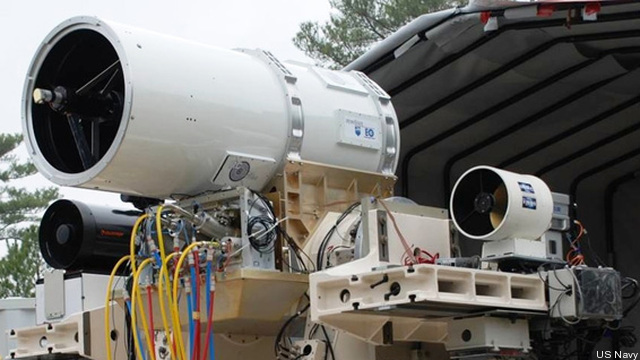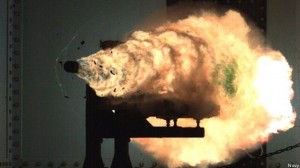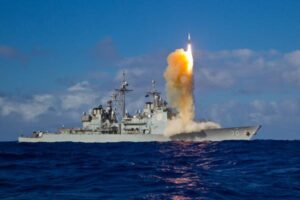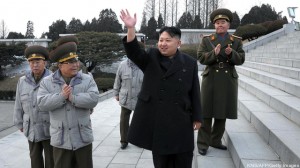Save Our Seoul: Can Lasers & Rail Guns Protect Korea?
Posted on

Experimental Navy laser
WASHINGTON: How do you stop 1,000 missiles? Current missile defenses can’t. They’re designed to stop a small attack from a rogue state. But even rogue states like North Korea — let alone power players like China’s Second Artillery — can now throw more missiles at us than we have interceptors to shoot them down.
That’s why the military, industry, and academia are hard at work on better ways to do stop them. Examples? Weapons like lasers that never run out of ammunition. But the North Korean threat turns out to be a hard test for the new weapons as well.
The stakes are high for the US and they rise to level of an existential threat to our allies. While North Korea can’t hit the West Coast yet, it already has about 1,000 ballistic missiles that can strike South Korea and parts of Japan. The vast majority of the barrage would be conventional explosives, like Saddam’s Scuds in 1991. But most experts believe the North is already “technically capable” of putting a nuclear warhead on a missile, veteran nuclear negotiator Joel Wit said Tuesday.
True, there would only be a handful of nukes among hundreds of missiles, but there’d be no way to tell which ones should be the top priority targets for our limited arsenal of interceptors. We’d be looking for a nuclear needle in a high-explosive haystack. What’s worse, the economics are on the impoverished Hermit Kingdom’s side. It costs much less to build a conventionally tipped Scud-type missile — which just has to hit the right city — than a defensive interceptor, which has to catch an enemy missile coming in. Can new technologies like lasers and rail guns change that balance?

Navy rail gun test
Yes, agreed half a dozen experts — potentially, to a point, and only with the proper tactics.
“Directed energy weapons have huge promise, but right now it’s just promise,” former Pentagon strategist Van Jackson said Tuesday, speaking alongside Wit at a 38 North press breakfast.
“In the long term, potentially these are extremely promising technologies,” agreed Aerospace Corporation engineer John Schilling. (For those who don’t know, Schilling’s employer is a national treasure where much of those old best and brightest in the national security space and intelligence world work.) “In the near term the United States has chosen to focus these technologies primarily in short-range tactical arena: laser weapons to defend Navy warships, laser weapons to destroy artillery rockets on the battlefield.” That’s a much narrower mission than defending South Korea’s vast urban sprawl. “So,” Schilling concluded, “right now we have nothing under development that would be particularly relevant against North Korean strategic missiles.”
Why are lasers and rail guns inherently short-ranged weapons? It turns out Pentagon investment decisions aren’t the only reason. Those pesky old laws of physics play a key role.
The fundamental problem with lasers is that they shoot light. Light moves in straight lines. You can hit anything you can see, but nothing you can’t. By contrast, missiles and artillery shells can arc over the horizon at distant, unseen targets. (The only way to redirect a laser beam is with a well-placed, high-quality mirror or a gravitational field about as strong as the sun’s — neither a practical battlefield technique). A low-flying target like a cruise missile will be blocked by the horizon until as little as 10 miles away, depending on terrain and how high up the laser turret is mounted. So physics limits lasers to protection of key targets — bases, ships, and maybe cities — rather than wide areas.
What’s more, lasers destroy their targets by applying intense heat, a high-tech version of a kid frying bugs with a magnifying glass. Cruise missiles and tactical ballistic missiles will go down to a 300 to 500 kilowatt laser, which could be built in a few years. Longer-range ballistic missiles, however, arc through space and then back down into the atmosphere. There warheads need to be proof against the heat of reentry and will laugh off any laser we can build for the foreseeable future.
Unlike lasers, rail guns can destroy a hardened warhead: 23 pounds of metal moving at Mach 7 can destroy pretty much anything. Rail guns can also fire indirectly at targets over the horizon. But they’re still limited to local defense. Current Navy designs could hit a stationary target over 100 miles away, but a moving target is much harder, and it gets harder the faster it moves and the farther away it is. Unlike an interceptor — a Patriot or a Navy Standard Missile, for example — the rail gun slug can’t change course to catch a target trying to evade. Retired Navy commander Bryan Clark estimates that the practical maximum range for a rail gun against an incoming missile is 20 to 40 miles.
“Lasers and rail guns will be short-range point defenses,” said Mark Gunzinger, who works with Clark at the Center for Strategic and Budgetary Assessments. “That’s why we say that electric weapons and kinetic missile interceptors are complementary.”
To cover a whole country, you want lots of range, and that’s what current anti-missile missiles give you. “To deal with a relatively small number of nuclear-capable missiles from North Korea that could be launched against a large target area, something with a large footprint like [a Navy] SM-3 makes sense,” Clark told me. “Even though it is expensive, it would enable a small number of interceptors at one launch location to protect a large tranche of land from missile attack.”
Unfortunately, Clark and Gunzinger agreed, the US military has focused too much on stopping a few rogue-state missiles and not enough on defending against large-scale salvos. If North Korea managed to launch hundreds of its roughly 1,000 ballistic missiles in rapid succession against the South — which would be no mean feat of military planning and logistics — we’d rapidly run out of high-end, high-cost interceptors to stop them. While only a fraction of the incoming warheads would be nuclear, there’d be no way to tell which one. Miss just one and the consequences would be on a scale unseen since Hiroshima.
That’s why many analysts are skeptical of missile defense in general. “An eighty percent success rate against a conventionally-armed missile attack can provide very valuable protection to a port facility or to troop formations,” said Greg Thielmann, a State Department veteran now with the Arms Control Association. “Letting only one of every five nuclear warheads explode over your city, however, doesn’t quite cut it.”
In the nightmare logic of nuclear warfare, those four warheads that got shot down are four nukes the enemy didn’t get to use on four other cities. In fact, if you assume missile defenses shoot down just 50 percent of incoming weapons, calculated CSBA’s Clark, “the attacker would need to launch more than seven missiles against each target to achieve a 95 percent confidence that each target would be hit.” Russia could do just that, but the North Koreans haven’t built enough nuclear weapons — yet — to throw multiple nukes against multiple targets.
Thielmann isn’t exactly reassured, however. In a democracy, a policy that probably saves almost all its citizens from nuclear annihilation is still an unacceptable risk. “I would contend that a government with missile defense in this circumstance would behave much like a government without missile defense,” he told me. “In either case, it would have to contemplate the prospect of a city being annihilated with nuclear weapons. And the attacking nuclear power would also have to anticipate that it would be nuked in return, whether or not its initial strike were degraded by missile defenses.” Mutual deterrence, he argues, is the best bet for peace.
If deterrence doesn’t work, however, missile defenses would be awfully nice to have in a war. But the peacetime politics of what to buy and where to put it could get ugly. The only way to shoot down missiles en masse is with lasers and rail guns — but those can only cover a limited area. The only way to shoot down missiles at long range is with other missiles — but those interceptors will be limited in numbers. This dilemma forces hard choices about which systems to buy more of and what to protect.
“Israel makes these choices by protecting population centers and shelter areas with point defenses, larger areas with ballistic missile defenses, and not defending less populated areas as densely” — or at all, said Clark. That’s politically tolerable against conventional warheads fired by Hezbollah or Hamas, but not necessarily against nuclear weapons.
In fact, the best defense against a large-scale launch might be a good offense. Hit North Korea “left of launch,” destroying not only missiles still on the ground but their logistical support and command-and-control structure. “Attacks on C2 targets could be very effective, especially if they are against an enemy that has a rigid, hierarchical command and control structure [like North Korea],” said Gunzinger.
“If history is any guide, you would have to combine missile defenses with suppression attacks on suspected missile launch sites and their command and control,” agreed Andrew Krepinevich, president of CSBA. “The ‘Great Scud Hunt’ of the First Gulf War is an interesting case. As I recall, while we did not obtain a single confirmed TEL [Transporter-Erector-Launcher vehicle] kill, once Scud hunt operations were under way the Iraqi attacks changed from coordinated salvoes to uncoordinated attacks — from a downpour to a drizzle.” We didn’t kill the Scud launchers, but we forced them to spend so much time hiding they couldn’t attack effectively.
The US hunted Iraqi Scuds with aircraft and special forces. Penetrating North Korean airspace or infiltrating its territory might be more difficult than the lightly defended Iraqi desert in 1991, however. The alternative is to strike from afar, with cruise missiles launched from heavy bombers and Navy ships.
The US currently doesn’t have land-based cruise missiles, just shorter-ranged rockets like the MLRS that could reach a short way into North Korea. CSBA argues — much to the consternation of arms control experts — that the US Army should develop long-range offensive missiles of its own.
“Long-range surface to surface missiles would be a key capability for attacking and degrading enemy strike capabilities,” Clark told me. “They can complement long-range air strikes by coming from multiple threat axes and locations.”
The more different directions we come from, the more different methods we use, the harder the enemy’s problem becomes. Offensive strikes, by themselves, can’t destroy all the enemy missiles on the ground. Defensive systems, by themselves, can’t destroy them all in the air. Together, however, our offensive might just whittle the enemy’s missile salvo down to something our defense can deal with. Let’s hope we never have to find out.
Subscribe to our newsletter
Promotions, new products and sales. Directly to your inbox.


